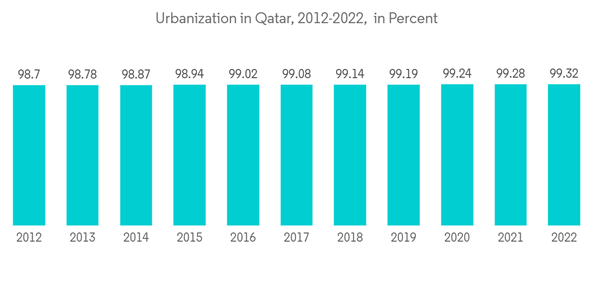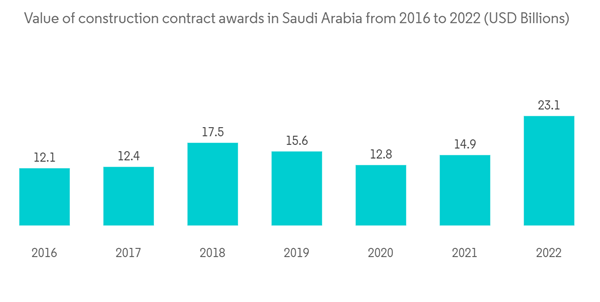Key Highlights
- The market is growing because the government has strong plans for economic diversification. These plans include developing and diversifying the economy and releasing its growth potential. The ultimate goal is to promote development and competitiveness by increasing government spending on key non-oil sectors and encouraging private investments. The market is driven by the increasing construction activities across the region and the lack of affordable housing for migrants working on the ongoing development projects in the GCC region.
- The COVID-19 outbreak had a big effect on the industry of building prefabricated homes in the GCC. The pandemic impacted growth across key sectors over the short to medium term, and recovery was expected to be slow. The spread of COVID-19 hit the prefabricated housing construction industry in Kuwait very hard. In 2020, the number of building permit wills dropped by 40%. Official data showed permits for private residential buildings dipped by around 46% in the first 10 months of 2020, as compared with the same period in 2019.
- There aren't enough affordable homes being built in Saudi Arabia because the country's population is growing and more people are moving there. This has encouraged the demand for prefabricated homes, as they are cost-effective and time-efficient. Moreover, energy efficiency, design flexibility, and faster completion are some of the other advantages of prefabricated buildings, which are anticipated to drive market growth.
GCC Prefabricated Housing Market Trends
Rising Demand for Single Family Type in the Region Fuelling the Market Demand
Single-family prefabricated housing is becoming increasingly popular in the GCC region due to its many advantages such as faster construction times, lower construction costs, greater energy efficiency, reduced environmental impact, and greater design flexibility. Many GCC governments are supporting the development of prefabricated housing as part of their efforts to boost economic reliance on the oil and gas industry.Prefabricated homes can be constructed in as little as 3-6 months, compared to traditional homes which can take up to 18-24 months to build. This is because prefabricated components can be manufactured off-site, in a controlled environment, and then assembled at the building site. Prefabricated homes can be up to 20% less expensive than traditional homes due to the use of standardized components and off-site manufacturing. This can save homeowners a significant amount of money over the long term.
The GCC region is experiencing rapid population growth and urbanization, which is putting a strain on the availability of affordable housing, prefabricated homes can help to address this need by providing an affordable and sustainable housing option. For example, According to the sources, the share of the urban population in the region is forecast to be 84% by 2030. The Red Sea project is located in Saudi Arabia and is expected to include over 1,300 prefabricated homes. The Lusali Marina Village, is located in Qatar and is expected to include 1,000 prefabricated homes. The Yas Acre Development is located in Abu Dhabi and is expected to include 800 prefabricated homes are some of the examples of single-family prefabricated housing projects in the region. As the demand for affordable, sustainable and efficient housing continues to grow, prefabricated homes are expected to play an increasingly important role in the GCC construction market.
Increasing demand for prefabricated housing in Saudi Arabia
In Saudi Arabia, the housing shortfall is overgrowing. To address this deficit, the government established a Real Estate Development Fund, which includes various financing schemes to increase the homeownership rates. In 2022, the density of Saudi Arabia's population amounted to 17.19 inhabitants per sq km. Factors such as growing construction activities, demand for affordable housing, social change, and a need to support the population with access to more plentiful and better-quality accommodation are expected to drive the prefabricated buildings market growth in Saudi Arabia.Additionally, the rising trend of providing housing facilities to migrant blue-collar laborers working on ongoing construction and industrial projects is also expected to boost the demand for modular construction. Affordable housing unavailability due to population growth and an influx of migrants has encouraged the prefabricated home demands in Saudi Arabia. Rapid urbanization and upcoming infrastructural projects further provide a thrust to the prefabricated structure market in Saudi Arabia.
The residential construction industry in Saudi Arabia is facing a shortage of affordable housing as a result of a growing population and an influx of expatriates. This has encouraged the demand for prefabricated homes, as they are cost-effective and time-efficient. Furthermore, prefabricated buildings are more environmentally friendly than conventionally constructed buildings, as they do not generate any on-site waste. This is projected to positively influence the market demand in the upcoming years. Moreover, energy efficiency, design flexibility, and faster completion are some of the other advantages of prefabricated building, which are anticipated to drive the market growth.
Backed by the Ministry of Housing, the modular construction undertaking is relied upon to help Saudi Arabia's homeownership strategy, which predicts 70% of residents owning homes by 2030. Moreover, Saudi Arabia's recent budget shows that the government is focusing on infrastructural reforms as per the 2030 vision.
Red Sea International (RSI) company has been awarded two contracts to manufacture and supply prefabricated steel structures for the MDLBEAST music festival in Riyadh. The contract value for these projects is SAR 58.87 million (USD 15.69 million). In October 2023, Saudi Arabia’s housing ministry penned a non-binding MOU with Silicon Valley-based high-tech builder Katerra. If the process is expedited, the agreement would see Katerra establish 8 factories in the kingdom, capable of manufacturing 50,000 housing units a year and creating 15,000 jobs.
GCC Prefabricated Housing Industry Overview
The GCC prefabricated housing market is fragmented. There are several international and domestic companies present in the GCC prefabricated housing market. The market is expected to grow during the forecast period due to the increase in prefabrication building investments and upcoming major projects in the country, among other factors that are driving the market. High capital requirements and rapid technological advancements are important barriers to entry for new participants.During the forecast period, there are chances for growth in the market, which is likely to drive competition in the market. Major players are Strabag Dubai LLC, Extra Co. Group of Companies, Albaddad International, Speed House Group of Companies, and Exeed Precast.
Additional Benefits:
- The market estimate (ME) sheet in Excel format
- 3 months of analyst support
This product will be delivered within 2 business days.
Table of Contents
Companies Mentioned (Partial List)
A selection of companies mentioned in this report includes, but is not limited to:
- Strabag Dubai LLC
- Extra Co Group of Companies
- Albaddad International
- Speed House Group of Companies
- Exeed Precast
- Memaar Building Systems (MBS)
- Dubox
- Bawan Metal Industries Co.
- Specialist Services Group
- Red Sea International*










